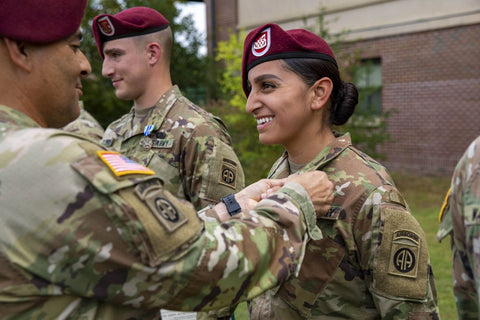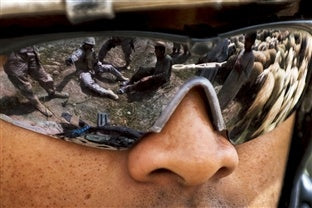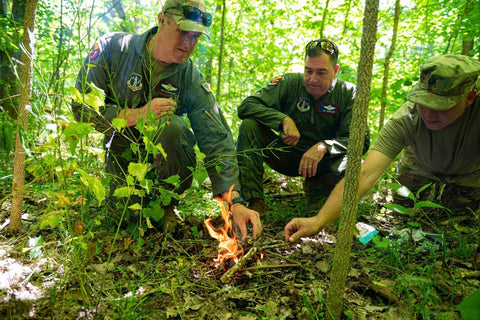Happy Birthday Space Force: A Look at the Youngest Military Branch

The U.S. Space Force (USSF) is responsible for organizing, training, and equipping Guardians (Space Force personnel) to conduct global space operations that enhance the way U.S. joint and coalition forces fight, while also offering decision makers military options to achieve national objectives. As the Space Force birthday approaches in December, we thought it would be great to showcase this vital and often misunderstood branch of service.
The USSF was established Dec. 20, 2019, the Space Force birthday. The National Defense Authorization Act was signed into law creating the first new branch of the armed services in 73 years and creating a brand new day to celebrate; the Space Force birthday. The establishment of the USSF resulted from widespread recognition that space was a national security imperative. When combined with the growing threat posed by near-peer competitors in space, it became clear to the United States that there was a need for a military service focused solely on pursuing superiority in the space domain.
For the upcoming Space Force birthday, it is important to note that for the last 60 years space capabilities have become essential to the way a modern military conducts operations. Investments in space capabilities have increased the effectiveness of operations in every other domain. The U.S. military is faster, better connected, more informed, precise, and lethal because of space.
The same premise—that space is critical—holds true for the average American; space capabilities are woven into the fabric of daily life. This is a big reason why the Space Force birthday is recognized. Daily, satellites connect people in every corner of the globe, monitor weather patterns, carry television broadcasts, and the timing and navigation services of the GPS constellation power global financial networks, enable international commerce, synchronize cell phone networks, and optimize critical infrastructure.
During the Space Force birthday it is important to remember that access to and freedom to operate in space underpins American national security and economic prosperity. Space is no longer free from conflict. America’s adversaries are seeking ways to deny the United States access to the space capabilities fundamental to the American way of war and modern way of life. They have developed an array of threats, both on Earth and in orbit, that continue to grow in scope, scale, and complexity.

On the Space Force birthday and every day, the Guardians of the USSF have been called to protect and defend American interests and to ensure U.S. forces, American allies, and the world never experience a day without space. Guardians serve across the globe, working 24/7 to design, acquire, field, test, operate, and defend the critical space systems the nation, and the world, rely upon.
USSF operations at the east and west coast launch bases provide services, facilities and range safety control for the conduct of Defense Department (DoD), NASA and commercial space launches. Through the command and control of all DoD satellites, satellite operators provide force-multiplying effects – continuous global coverage, low vulnerability and autonomous operations. Satellites provide essential in-theater secure communications, weather and navigational data for ground, air and fleet operations and threat warning.
Ground-based and space-based systems monitor ballistic missile launches around the world to guard against a surprise missile attack on North America. A global network of space surveillance sensors provides vital information on the location of satellites and space debris for the nation and the world. Maintaining space superiority is an emerging capability required to protect U.S. space assets from hostile attacks.
As the Space Force birthday approaches, it’s good to know what the USSF logo means. The logo is on a dark blue disc, between two constellations in white, a light blue globe grid-lined in silver surmounted by a silver delta both encircled diagonally by a white orbit ring, all beneath a white Northern star in the upper left portion of the disc and above the roman numerals “MMXIX” arching in white below. Encircling the disc is a dark blue designation band edged with an inner and outer border and between two deltas, the inscription “UNITED STATES SPACE FORCE” at top.
Dark blue and white combine to represent the vast recesses of outer space. The Delta Wing evokes historic ties to the earliest days of the U.S. Air Force space community, and symbolizes change and innovation. It also represents all variations of space vehicles that support our National Defense Strategy and National Security Space Strategy. Dark and light shades of grey within the delta embody the 24/7 operations of the Space Force, while the placement and upward orientation of the delta reveals the central role of the Space Force in defending the space domain. The Globe represents the terrestrial home of the U.S. Space Force and it’s support to the joint warfighters. The Elliptical Orbit [around the globe] signifies defense and protection from all adversaries and threats emanating from the space domain. It also represents ongoing interagency cooperation and allied partnerships. The white Polaris symbolizes the guiding light of security and alludes to a constant presence and vigilance in space now and in the future. Two clusters of small stars represent the space assets developed, maintained, and operated by the U.S. Space Force. The three larger stars symbolize the Organize, Train, and Equip functions of the Space Force.

The designed blazoned in full color on a circular dark blue background with the Roman numerals MMXIX (2019) representing the year of activation. The designation band inscribed “UNITED STATES SPACE FORCE” above all in white.
Air Force Space Command (AFSPC) was redesignated as the USSF as an initial step in establishing the USSF. Over time, the DOD vision is to consolidate space missions from across the armed forces into the USSF, as appropriate and consistent with law.
The USSF headquarters is in the Pentagon, just like the Army, Navy, Marine Corps, and Air Force. This staff focuses on managing a fully functioning headquarters; executing the full scope of its organize, train, and equip responsibilities. Something to think about on the Space Force birthday.
As a new military service, the U.S. Space Force will leverage the Department of the Air Force for more than 75 percent of its enabling functions to significantly reduce cost and avoid duplication. That’s a great gift for the Space Force birthday. The Department of the Air Force will provide support functions that includes logistics, base operating support, IT support, audit agencies, etc.
(EDITOR's NOTE: Most of this article is from Space Force's website and it is public information in the public domain.)







































